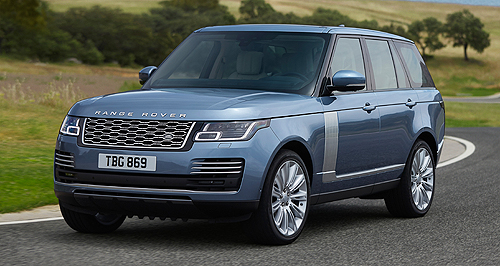Range Rover goes PHEV too
BY RON HAMMERTON | 11th Oct 2017

Also bearing the P400e badge, the petrol-electric Rangie is powered by the same 297kW/640Nm petrol-electric powertrain as the Sport, delivering an identical 51km of all-electric driving range and 2.8 litres per 100km fuel economy on the European combined test cycle.
The newest Range Rover variant is due to touch down in Australia as part of the facelifted 2018 range in March, about a month before the revised Range Rover Sport arrives.
The refreshed Range Rover line-up – with a bunch of enhancements including new connectivity and more sumptuous seats – also includes the most powerful variant yet, the SVAutobiography Dynamic powered by a 416kW version of JLR’s supercharged 5.0-litre V8, representing an 11kW increase on the current 405kW SVAutobiography.
Dynamic by name and dynamic by nature, the new performance leader can scurry to 100km/h in 5.4 seconds.
One step down from the 416kW flagship, the Range Rover Autobiography will get a 386kW version of the blown 5.0-litre V8 at a more affordable price.
JLR Australia is yet to announce pricing for the 2018 range, beyond a starting price of $190,000 plus on-road costs – $6700 above the current most affordable Range Rover, the $183,300 3.0-litre diesel Vogue.
JLR Australia managing director Matthew Wiesner said the 2018 Range Rover took the luxury SUV to new heights, delivering enhanced refinement, luxury and all-terrain capability.
“The new PHEV powertrain isn’t simply a no-compromise solution – it builds on the traditions of our flagship SUV and delivers heightened refinement and comfort with impressive performance and efficiency,” he said.
Available in both standard and long-wheelbase, the PHEV Range Rover P400e continues JLR’s plan to roll out electrified powertrains in all of its Jaguar and Land Rover models by 2020.
However, it is not the first Range Rover with electric boost, as the current line-up includes a conventional hybrid, the Vogue SE.
The P400e marries a 221kW Ingenium 2.0-litre petrol engine with an 85kW electric motor for combined peak power of 297kW.
Driving all four wheels, the powertrain can push the big Range Rover from zero to 100km/h in 6.8 seconds and on to a maximum speed of 220km/h.
The 13.1kWh lithium-ion battery can be charged in less than three hours with a 32-amp fast charger, and around seven and a half hours from a standard 10-amp home socket.
As with the PHEV Range Rover Sport, the P400e Range Rover incorporates the electric motor within the eight-speed automatic transmission, lined up longitudinally behind the petrol engine and hooking into the all-wheel-drive system. JLR says off-road ability is uncompromised, with the Terrain Response system getting a unique calibration to distribute torque from the electric motor to the wheels for greater control at low speeds.
The powertrain has two driving modes – full-electric and hybrid. Within hybrid, the driver can select a save function that prevents the battery dropping below a certain level.
While the new powertrains are grabbing the headlines, the new seats implanted in the 2018 Range Rover might be the deal-sealer for customers.
Based on all-new frames that provide 24-way electric movement, the seats are wider and softer than before, and even include electrically heated armrests and 25 Hot Stone massage functions in the seat backs. Passengers even get heated calf and foot rests.
For the first time, the seats can be controlled by a smart phone app, inside or outside the vehicle.
The infotainment system has been upgraded, getting two high-definition 10.0-inch touchscreens on the centre console. JLR says information can be swiped from one screen to the other, “making the layout highly intuitive and engaging to operate, with unrivalled functionality”.
Seventeen connection points include domestic plug sockets, USB, HDMI and 12-volt, while a 4G WiFi hotspot can connect up to eight devices.
Apart from tech enhancements, the Range Rover’s styling also gets a tweak, with a new-look graphite mesh grille with chrome inserts, and a revised rear bumper with integrated metal tailpipe finishers.
Land Rover chief design officer Gerry McGovern said changes to the 2018MY Range Rover did not mess with the vehicle’s core strengths.
“Our customers are very clear about what they want from any new Range Rover,” he said. “‘Don’t change it, just make it better,’ they tell us. So everything we've done has been about enhancing our flagship SUV.”